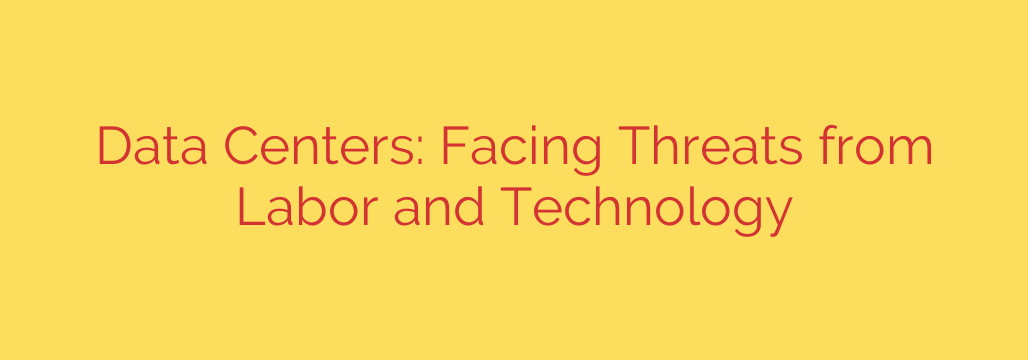
Securing the Digital Backbone: Navigating the Top Threats to Modern Data Centers
Data centers are the unseen engines of our digital world. They power everything from cloud computing and streaming services to global finance and critical government operations. As our reliance on this digital infrastructure grows, so do the threats against it. Today, data center operators face a complex and evolving risk landscape, with significant challenges emerging from two key areas: human capital and advanced technology.
Protecting these vital facilities is no longer just about firewalls and fences. It requires a deep understanding of the converging threats that can compromise operations from both the inside and the outside.
The Human Factor: Labor Shortages and Insider Risks
While cyberattacks grab headlines, one of the most pressing challenges for data centers is human-centric. The industry is grappling with a combination of talent scarcity and the persistent danger of insider threats.
A Critical Shortage of Skilled Talent: There is a significant and growing gap between the demand for qualified data center professionals—including engineers, IT specialists, and security personnel—and the available supply. This shortage can lead to overworked staff, delayed maintenance, and mistakes that create security vulnerabilities. When teams are stretched thin, critical security protocols can be overlooked, opening the door to potential breaches.
The Ever-Present Insider Threat: An “insider threat” doesn’t always mean a malicious spy. It can be an unintentional error made by a well-meaning but undertrained employee or a disgruntled worker seeking to cause harm. A single employee with privileged access can cause catastrophic damage, whether by accidentally misconfiguring a system, falling for a phishing scam, or intentionally stealing data or sabotaging equipment.
Securing against human-related risks requires a proactive, people-focused strategy. This includes investing heavily in ongoing training, fostering a strong security-aware culture, and implementing the principle of least privilege, ensuring employees only have access to the systems absolutely necessary for their jobs.
The Technological Battlefield: More Than Just a Cyber Threat
On the technology front, the threats have become more sophisticated and multifaceted. The danger extends beyond traditional hacking and now includes physical risks enabled by new technologies and attacks on critical support systems.
Advanced and Automated Cyberattacks: Malicious actors are now using AI and machine learning to launch faster, more sophisticated, and highly targeted attacks. Ransomware can paralyze an entire facility’s operations, while Distributed Denial-of-Service (DDoS) attacks can sever its connection to the outside world. The speed of these automated attacks often outpaces human response capabilities, making automated defense systems essential.
Physical Breaches with a High-Tech Edge: The physical security of a data center is also being challenged by modern technology. Drones can be used for surveillance to identify weaknesses in perimeter security, while advanced tools can be used to bypass traditional locks and access controls. A physical breach can be just as devastating as a cyberattack, leading to data theft, equipment damage, or a complete shutdown.
Vulnerabilities in Critical Infrastructure: Data centers are complex ecosystems that depend on a constant, stable supply of power and cooling. An attack doesn’t have to target the servers themselves; it can target the support infrastructure. A successful attack on a facility’s power grid or HVAC system can trigger a cascading failure, leading to massive downtime and irreversible hardware damage.
Forging a Resilient Defense: Actionable Security Tips
To effectively protect modern data centers, operators must adopt an integrated security posture that addresses both human and technological threats simultaneously. The old model of siloing physical and cybersecurity is no longer viable.
Here are essential strategies to build a more resilient defense:
Implement a Zero Trust Architecture: Operate under the assumption that threats can exist both inside and outside your network. Verify everything and trust no one by default. This means rigorously authenticating every user and device trying to access the network, regardless of their location.
Unify Physical and Cybersecurity Teams: Foster collaboration between your IT security and physical security teams. They must share intelligence and coordinate responses, as a threat that starts in the digital realm can easily transition to a physical one, and vice versa.
Leverage AI for Threat Detection: Fight fire with fire. Use AI and machine learning-powered security platforms to monitor network traffic, user behavior, and system performance in real-time. These tools can detect anomalies and predict potential threats far faster than human teams.
Conduct Comprehensive Employee Vetting and Training: Your people are your first line of defense. Implement rigorous background checks for all staff and contractors with access to sensitive areas. Follow this with continuous security awareness training that covers phishing, social engineering, and proper security protocols.
Secure Your Supply Chain: A vulnerability can be introduced long before a piece of equipment reaches your facility. Thoroughly vet all hardware and software vendors to ensure they adhere to strict security standards.
The security of our digital future depends on the resilience of our data centers. By recognizing the interconnected nature of modern threats and adopting a holistic, proactive security strategy, operators can protect their critical assets and ensure the continuous, reliable service the world depends on.
Source: https://datacentrereview.com/2025/07/labour-and-technology-are-threatening-the-future-of-data-centre-growth/








